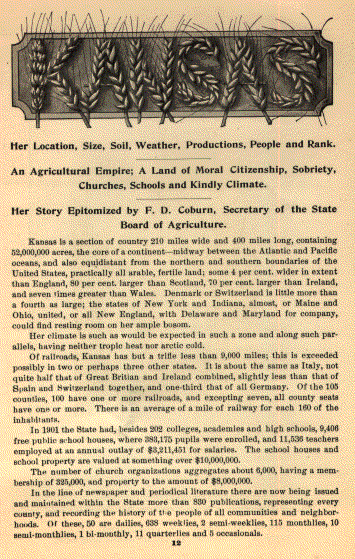| Grand Army of the Republic | page 12 text |
Her Locaton, Size, Soil, Weather, Productions, People and Rank.
An Agricultural Empire; A Land of Moral Citizenship, Sobriety,
Churches, Schools and Kindly Climate.
Her Story Epitomized by F. D. Coburn, Secretary of the State
Board of Agriculture.
Kansas is a section of country 210 miles wide and 400 miles long, containing 52,000,000 acres, the core of a continent - midway between the Atlantic and Pacific oceans, and also equidistant from the northern and southern boundaries of the United States, practically all arable, fertile land; some 4 per cent. wider in extent than England, 80 per cent. larger than Scotland, 70 per cent. larger than Ireland, and seven times greater than Wales. Denmark or Switzerland is little more than a fourth as large; the states of New York and Indiana, almost, or Maine and Ohio, united, or all New England, with Delaware and Maryland for company, could find resting room on her ample bosom.
Her climate is such as would be expected in such a zone and along such parallels, having neither tropic heat nor arctic cold.
Of railroads, Kansas has but a trifle less than 9,000 miles; this is exceeded possibly in two or perhaps three other states. It is about the same as Italy, not quite half that of Great Britian and Ireland combined, slightly less than that of Spain and Switzerland together, and one-third that of all Germany. Of the 105 counties, 100 have one or more railroads, and excepting seven, all county seats have one or more. There is an average of a mile of railway for each 160 of the inhabitants.
In 1901 the State had, besides 202 colleges, academies and high schools, 9,406 free public school houses, where 383,175 pupils were enrolled, and 11, 536 teachers employed at an annual outlay of $3,211,451 for salaries. The school houses and school property are valued at something over $10,000,000.
The number of church organizations aggregates about 6,000, having a membership of 325,000, and property to the amount of $9,000,000.
In the line of newspaper and periodical literature there are now being issued and maintained within the State more than 830 publications, representing every county, and recording the history of the people of all communities and neighborhoods. Of these, 50 are dailies, 838 weeklies, 2 semi-weeklies, 115 monthlies, 10 semi-monthlies, 1 bi-monthly, 11 quarterlies and 5 occasionals.

![]()
Department of Kansas, G.A.R. to the 36th National Encampment, Washington DC, Oct. 1902. Transcribed by Carolyn Ward, 1997; 1998 HTML coding by Kenneth Thomas; modified 2014 by Carolyn Ward.
 Back to the GAR Index Page
Back to the GAR Index Page
 Back to the KSGenWeb
Digital Library Page
Back to the KSGenWeb
Digital Library Page
 Back to the KSGenWeb State Index
Page
Back to the KSGenWeb State Index
Page
